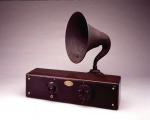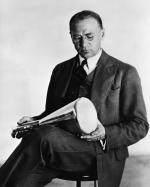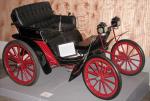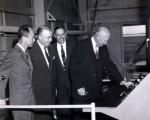Chapter three: Science and Invention in the Twentieth Century
At the dawn of the 20th century, Pennsylvania was an industrial powerhouse and international center of technological innovation. Pennsylvanians had little doubt that their state would continue its explosive economic growth producing steel, textiles, locomotives and railroad cars, machine parts, and a broad range of manufactured goods in high demand at home and abroad. In the 1900s the Commonwealth's vaunted heavy industries did indeed rise to new heights, but then experienced precipitous declines. In the place of coal mining, steel, and manufacturing, new science-based economic sectors emerged as Pennsylvania became a leading innovator in the electronics, chemical, and pharmaceutical industries.
In the early 20th century, the harnessing of electricity produced explosive economic growth. The two companies that dominated this industry were General Electric and the Westinghouse Electrical and Manufacturing Company, based in Pittsburgh, which pioneered the use of Alternating Current (AC), and manufactured a vast array of electrical products. In 1906, Westinghouse established its own in-house research division, which in the decades to follow employed world-class scientists and engineers, including Nicolas Tesla,
Westinghouse Electrical and Manufacturing Company, based in Pittsburgh, which pioneered the use of Alternating Current (AC), and manufactured a vast array of electrical products. In 1906, Westinghouse established its own in-house research division, which in the decades to follow employed world-class scientists and engineers, including Nicolas Tesla, Frank Conrad and Vladimir Zworykin, who made major contributions to the development of electrical and steam power plants, electrical appliances,
Frank Conrad and Vladimir Zworykin, who made major contributions to the development of electrical and steam power plants, electrical appliances,  commercial radio,
commercial radio, shortwave radio,television, radar, and nuclear energy.
shortwave radio,television, radar, and nuclear energy.
In Philadelphia, A. Atwater Kent (1873) and the Philadelphia Storage Battery Company (Philco) also turned their attention to the development of electrical appliances and equipment. A manufacturer of small motors and fans in the 1890s, Atwater Kent in the 1920s became the nation's largest producer of radio receivers, only to be overtaken by Philco in the late 1920s, which dominated the radio market for the next two decades. Hoping to win the race to develop a viable technology for the transmission of moving images, Philco in 1931 lured inventor Philo T. Farnsworth from San Francisco to Philadelphia. After a short and unsuccessful partnership, Farnsworth set up his own Television Company in Wyndmoor, Pa., and conducted the first American demonstration of television at Philadelphia's Franklin Institute 1934.
Philo T. Farnsworth from San Francisco to Philadelphia. After a short and unsuccessful partnership, Farnsworth set up his own Television Company in Wyndmoor, Pa., and conducted the first American demonstration of television at Philadelphia's Franklin Institute 1934.
Blessed with an extraordinary array of skilled machinists, agricultural equipment manufacturers, iron and steel mills, and other resources, Pennsylvania in the early 1900s was also well positioned to take a leading role in the development of the American automobile industry. More than 100 Pennsylvania companies manufactured automobiles in the early 1900s, including automotive pioneer Charles Duryea, who between 1901 and 1914 struggled to produce affordable vehicles in Reading, Pa., an iron town well known for its horse carriage builders. Detroit, however, soon dominated the industry, and drew upon Pennsylvania expertise. Ford and other Detroit automakers used the carburetors introduced by the
Charles Duryea, who between 1901 and 1914 struggled to produce affordable vehicles in Reading, Pa., an iron town well known for its horse carriage builders. Detroit, however, soon dominated the industry, and drew upon Pennsylvania expertise. Ford and other Detroit automakers used the carburetors introduced by the  Holley Brothers of Bradford, Pa., the electrical starters patented and manufactured by Philadelphia's Atwater Kent, and molded steel bodies first developed by the Budd Company in Philadelphia.
Holley Brothers of Bradford, Pa., the electrical starters patented and manufactured by Philadelphia's Atwater Kent, and molded steel bodies first developed by the Budd Company in Philadelphia.
In the 1900s the increasing complexity of science and the expense of research, development, and production drove innovation into professional research facilities. At Philadelphia's Wistar Institute of Anatomy and Biology, the nation's first independent medical-research facility, scientists contributed to the development of vaccines for rabies, German measles, and other viruses. Here, researchers in 1906 bred the WISTARAT, the first standardized laboratory animal. In 1905, Bryn Mawr biologist Nettie Stephens determined that "X" and "Y" chromosomes determined sex. Working at the Phipps Institute in Philadelphia,
Wistar Institute of Anatomy and Biology, the nation's first independent medical-research facility, scientists contributed to the development of vaccines for rabies, German measles, and other viruses. Here, researchers in 1906 bred the WISTARAT, the first standardized laboratory animal. In 1905, Bryn Mawr biologist Nettie Stephens determined that "X" and "Y" chromosomes determined sex. Working at the Phipps Institute in Philadelphia,  Florence B. Seibert the 1920s developed a safe process for intravenous therapies. At Penn State in the 1930s, scientist Russell Marker began groundbreaking research into steroids.
Florence B. Seibert the 1920s developed a safe process for intravenous therapies. At Penn State in the 1930s, scientist Russell Marker began groundbreaking research into steroids.
Meanwhile, amateur inventors continued to toil in basement and attic workshops. In the early 1900s, Father Josef Murgas, a Slovak priest in Wilkes-Barre, Pa., conducted pioneering experiments in wireless telephony. In the 1920s, Walter Diemer, an accountant with the Fleer Chewing Gum Company in Philadelphia, accidently stumbled upon the recipe for bubble gum. In 1945, Philadelphia naval engineer Richard James patented the Slinky.
Father Josef Murgas, a Slovak priest in Wilkes-Barre, Pa., conducted pioneering experiments in wireless telephony. In the 1920s, Walter Diemer, an accountant with the Fleer Chewing Gum Company in Philadelphia, accidently stumbled upon the recipe for bubble gum. In 1945, Philadelphia naval engineer Richard James patented the Slinky.
The wars of the 20th century were fought in research laboratories as well as in factories and on battlefields. During World War II, Pennsylvania's industries stepped up their production and contributed to the innovations needed to win the war. Westinghouse made significant improvements in radar and weapons systems, and produced the nation's jet engine. The American Bantam Car Co. in Butler, Pa., designed and produced the first jeeps. Philadelphia's Philco Corporation created the Plexiglas canopies for American aircraft. In nearby West Chester,
jeeps. Philadelphia's Philco Corporation created the Plexiglas canopies for American aircraft. In nearby West Chester,  G. Raymond Rettew developed a method for the mass production of penicillin that saved millions of lives. Hired to improve the firing tables for artillery pieces, University of Pennsylvania engineers J. Presper Eckert, Jr. and John Mauchly in 1945 designed
G. Raymond Rettew developed a method for the mass production of penicillin that saved millions of lives. Hired to improve the firing tables for artillery pieces, University of Pennsylvania engineers J. Presper Eckert, Jr. and John Mauchly in 1945 designed  ENIAC, the world's first digital computer. In the early 1950s, their
ENIAC, the world's first digital computer. In the early 1950s, their  BIVAC/UNIVAC line of computers incorporated retrievable memory, keyboards for data entry, and user-friendly programs.
BIVAC/UNIVAC line of computers incorporated retrievable memory, keyboards for data entry, and user-friendly programs.
Pennsylvania companies that built electronics, planes, radar, transistors, and other military equipment then continued to develop new technologies. Specializing in the quality fabricator of precision aircraft parts during the war, the Lavelle Company of Newtown became one of the nation's most trusted aerospace contractors and participate in the construction of the nation's First Weather Satellite, TIROS I, launched in 1960. The Johnsville plant of the Brewster Aeronautical Corporation evolved into the
First Weather Satellite, TIROS I, launched in 1960. The Johnsville plant of the Brewster Aeronautical Corporation evolved into the  Johnsville Naval Air Development Center, which conducted critical work for NASA and the American space program. The laminate technology developed by the General Textile Mills in Carbondale for parachutes and helmets allowed that company-now known as Gentex-to become a leading manufacturer of the plastics and polymers used in high performance occupations. After building the nation's first commercial nuclear reactor in Shippingport, Pa., in the 1950s, Westinghouse produced solid-core nuclear rocket engines for the American space program.
Johnsville Naval Air Development Center, which conducted critical work for NASA and the American space program. The laminate technology developed by the General Textile Mills in Carbondale for parachutes and helmets allowed that company-now known as Gentex-to become a leading manufacturer of the plastics and polymers used in high performance occupations. After building the nation's first commercial nuclear reactor in Shippingport, Pa., in the 1950s, Westinghouse produced solid-core nuclear rocket engines for the American space program.
The Cold War fostered ongoing collaborations between higher education, the federal government and American businesses. Supported by federal funding and private partnerships, the University of Pittsburgh, the University of Pennsylvania,
University of Pittsburgh, the University of Pennsylvania, Penn State, and other Commonwealth universities emerged as major research centers. Pharmaceutical manufacturers produced a growing array of prescription drugs, including antibiotics, antihistamines, cortisone, tranquilizers, chemical therapies, and a growing arsenal of vaccines, including one for the dreaded childhood disease of polio, developed in the 1950s by Jonas Salk at the University of Pittsburgh. Pennsylvania's colleges and universities educated and employed world-class scientists and engineers, including
Penn State, and other Commonwealth universities emerged as major research centers. Pharmaceutical manufacturers produced a growing array of prescription drugs, including antibiotics, antihistamines, cortisone, tranquilizers, chemical therapies, and a growing arsenal of vaccines, including one for the dreaded childhood disease of polio, developed in the 1950s by Jonas Salk at the University of Pittsburgh. Pennsylvania's colleges and universities educated and employed world-class scientists and engineers, including  Christian B. Anfinsen, who in 1972 won a Nobel Prize for his work on ribonuclease enzymes.
Christian B. Anfinsen, who in 1972 won a Nobel Prize for his work on ribonuclease enzymes.
Thrilled by the benefits of pesticides, plastics, synthetic fibers, and other products of modern science, Americans were often slow to recognize and respond to the unintended byproducts of "progress." As a center of industry, the Commonwealth also felt the impact of modern chemical pollution. In 1948, air pollution became a national concern after the Donora smog, produced by toxic emissions from the Donora Zinc Works, left twenty people dead and thousands ill in a Monongahela mill town. Published in 1962, Silent Spring, written by Springdale's
Donora smog, produced by toxic emissions from the Donora Zinc Works, left twenty people dead and thousands ill in a Monongahela mill town. Published in 1962, Silent Spring, written by Springdale's Rachel Carson, focused the nation's attention on the dangers of pesticides and helped launch the environmental movement. Sixteen years later, the partial meltdown of the reactor core at the
Rachel Carson, focused the nation's attention on the dangers of pesticides and helped launch the environmental movement. Sixteen years later, the partial meltdown of the reactor core at the  Three Mile Island Nuclear Power Plant near Harrisburg, set off a national movement against nuclear power plants for domestic energy supply.
Three Mile Island Nuclear Power Plant near Harrisburg, set off a national movement against nuclear power plants for domestic energy supply.
Deindustrialization in the late 1900s hit the Commonwealth hard, and forced it to make deep changes in its economy. The concentration of universities and colleges, medical schools, and pharmaceutical companies in southeastern Pennsylvania enabled that region to develop into one of the nation's largest bio-pharmaceutical corridors. In the year 2000, Pennsylvania was home to more than 125 bio-pharmaceutical companies and more than 2,000 biosciences-related companies. Despite the loss of heavy industries, the Commonwealth could still boast an economy that would rank as the world's sixteenth largest. Today, Pennsylvania remains a center of scientific research and innovation in medicine, nanotechnology, information technologies, bioservices, manufacturing, and telecommunications.
In the early 20th century, the harnessing of electricity produced explosive economic growth. The two companies that dominated this industry were General Electric and the
In Philadelphia, A. Atwater Kent (1873) and the Philadelphia Storage Battery Company (Philco) also turned their attention to the development of electrical appliances and equipment. A manufacturer of small motors and fans in the 1890s, Atwater Kent in the 1920s became the nation's largest producer of radio receivers, only to be overtaken by Philco in the late 1920s, which dominated the radio market for the next two decades. Hoping to win the race to develop a viable technology for the transmission of moving images, Philco in 1931 lured inventor
Blessed with an extraordinary array of skilled machinists, agricultural equipment manufacturers, iron and steel mills, and other resources, Pennsylvania in the early 1900s was also well positioned to take a leading role in the development of the American automobile industry. More than 100 Pennsylvania companies manufactured automobiles in the early 1900s, including automotive pioneer
In the 1900s the increasing complexity of science and the expense of research, development, and production drove innovation into professional research facilities. At Philadelphia's
Meanwhile, amateur inventors continued to toil in basement and attic workshops. In the early 1900s,
The wars of the 20th century were fought in research laboratories as well as in factories and on battlefields. During World War II, Pennsylvania's industries stepped up their production and contributed to the innovations needed to win the war. Westinghouse made significant improvements in radar and weapons systems, and produced the nation's jet engine. The American Bantam Car Co. in Butler, Pa., designed and produced the first
Pennsylvania companies that built electronics, planes, radar, transistors, and other military equipment then continued to develop new technologies. Specializing in the quality fabricator of precision aircraft parts during the war, the Lavelle Company of Newtown became one of the nation's most trusted aerospace contractors and participate in the construction of the nation's
The Cold War fostered ongoing collaborations between higher education, the federal government and American businesses. Supported by federal funding and private partnerships, the
Thrilled by the benefits of pesticides, plastics, synthetic fibers, and other products of modern science, Americans were often slow to recognize and respond to the unintended byproducts of "progress." As a center of industry, the Commonwealth also felt the impact of modern chemical pollution. In 1948, air pollution became a national concern after the
Deindustrialization in the late 1900s hit the Commonwealth hard, and forced it to make deep changes in its economy. The concentration of universities and colleges, medical schools, and pharmaceutical companies in southeastern Pennsylvania enabled that region to develop into one of the nation's largest bio-pharmaceutical corridors. In the year 2000, Pennsylvania was home to more than 125 bio-pharmaceutical companies and more than 2,000 biosciences-related companies. Despite the loss of heavy industries, the Commonwealth could still boast an economy that would rank as the world's sixteenth largest. Today, Pennsylvania remains a center of scientific research and innovation in medicine, nanotechnology, information technologies, bioservices, manufacturing, and telecommunications.


















